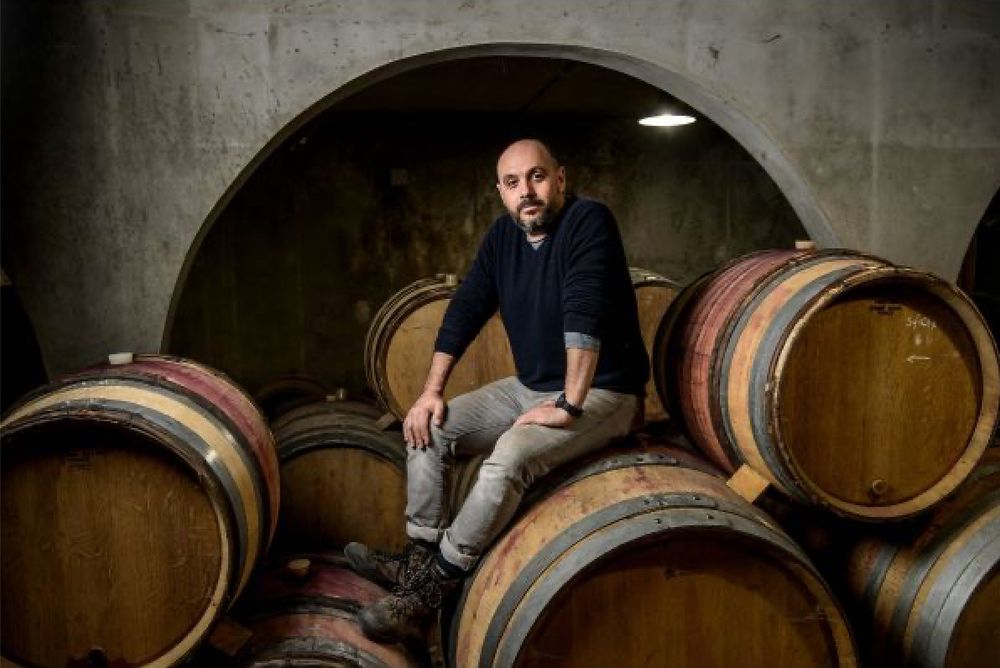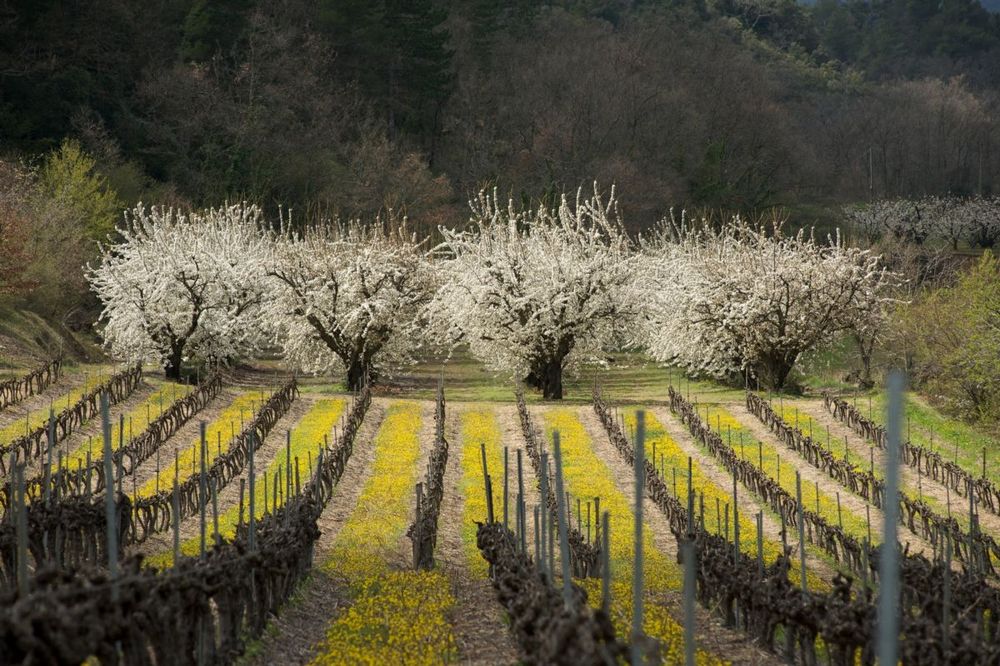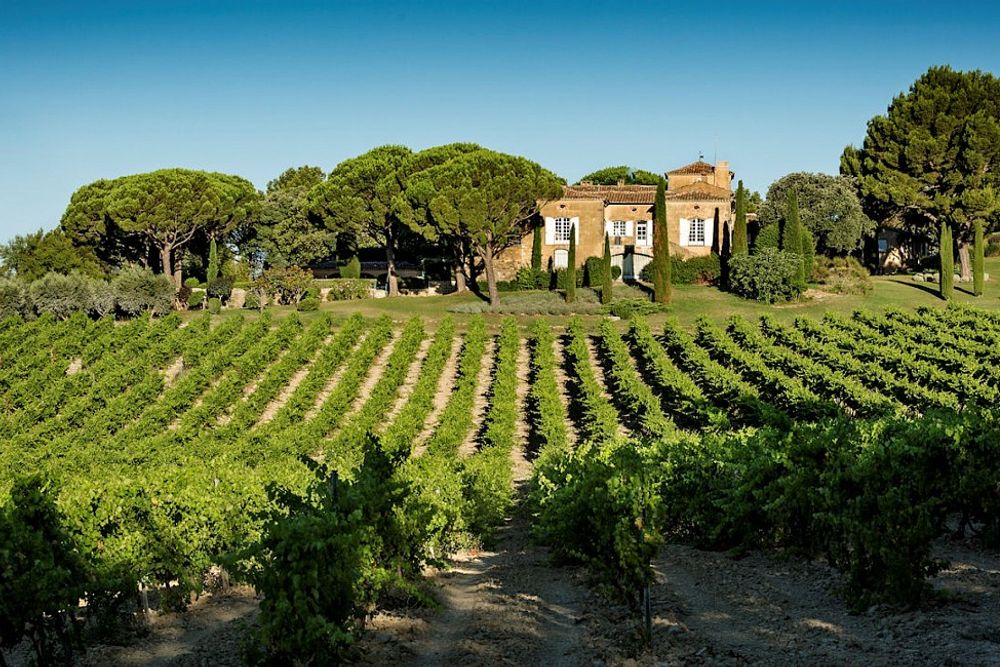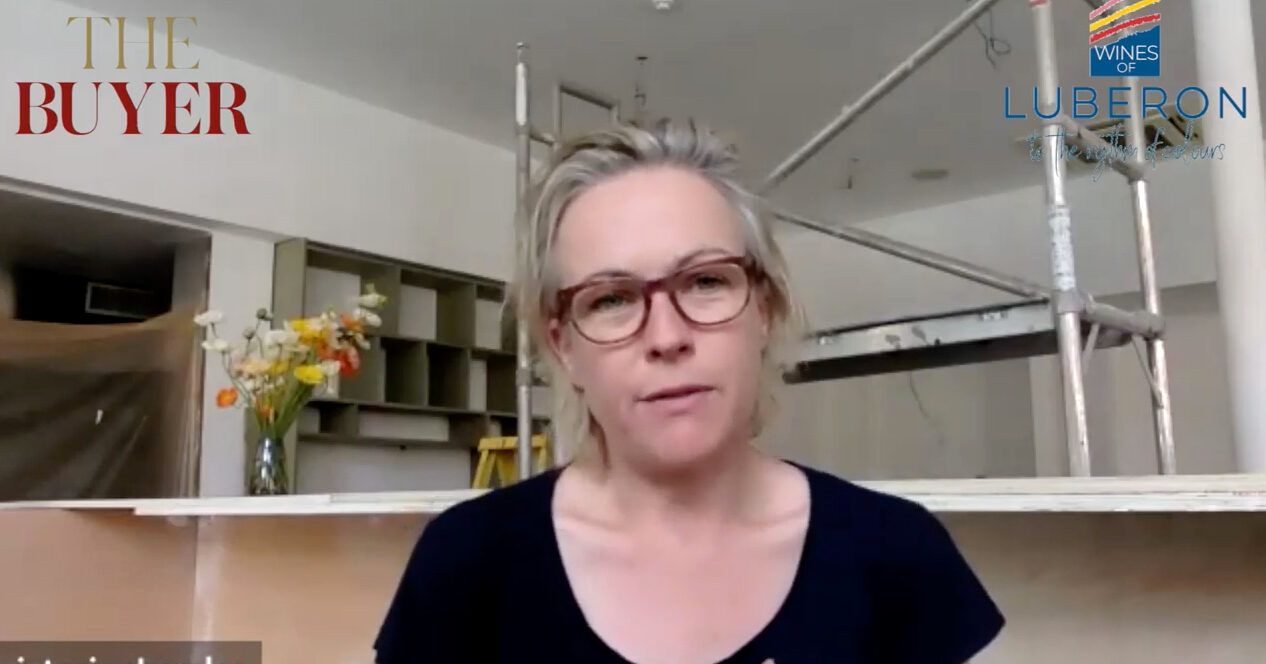In the first report from our Luberon debate the buyers’ made the case for the region’s quality rosé wines, here they assess the strengths and merits of its red and white wines. Click here to read the first report.
The Buyer would like to thank Wines of Luberon and our panel of buyers for their time in making this debate happen. Our buyer panel line-up included:
- Victoria Sharples, wine consultant, opening new wine bar in Lower Highgate, north London.
- Noel Reid, founder of Rediscover Wines.
- Tim Killen, business development manager, Alpine Wines.
- Joshua Castle, head sommelier, Noble Rot
- Simon Lloyd, director, Lloyd Wines
- Mattia Scarpazza, head sommelier, Petersham Nurseries
- Matt Walls, wine writer, and specialist in Luberon wines
(You can watch a recording of the full debate below)
The Whites
The buyers were pretty much united in their appreciation of what they saw as Luberon delivering the “classic” white wine styles that you expect from the Rhône. Where it is the blend and combinations of different varieties, often using Vermentino as the hero grape variety, that start to build a picture and identify of the region, said Matt Walls. “The tradition in the southern Rhône is to blend, in the northern Rhône it’s not to blend,” he adds.
Victoria Sharples said she is a big fan of blends from anywhere in the world, but it is the quality that is coming through in the Luberon where “they become so compelling as a drink and it’s more than just a white wine that happens to be from southern Rhône. You want to drink more. You want to dive into the glass as there is so much going on”.
What really stood out was the precise nature of the wines, added Walls, where you “get a real sense of place” that is expressed through the “elevated acidity” and the “grapefruit pithiness” that comes through from the Vermentino.
Although the panel only tasted two white wines, they were markedly different in overall style, whilst still carrying the key characteristics of controlled acidity and freshness. Noel Reid said the contrast between the two wines could not be more marked between the leaner and big, rich styles. But agreed it was the freshness in both that carried them home. “But they are [both] very, very good,” was the consensus opinion.
That’s where the Vermentino more than plays its part, felt Mattia Scarpazza, and is becoming such an important grape variety in hot wine regions around the world, be it California, Italy or here in Luberon, for helping the wines keep their freshness. But in the Luberon it is also the citrus and richness that makes it “quite unique”.
It is also the value for money that the Luberon offers that shines through with its Vermentino styles, said Tim Killen at Alpine Wines, wines that would cost far more if they came from other regions, like Corsica, for example. “That’s where Luberon has a price advantage.”
(Click here to hear the UK buyers explain the role and influence of Vermentino and acidity in the white wine blends of the Luberon)
Joshua Castle at Noble Rot said there were elements in the whites that reminded him of white blends from northern Spain – particularly where there is a strong Grenache Blanc influence in the wine.
He also felt that the whites, bottled under cork, could also “benefit from a couple of years of age” where there is not a risk of what he sees as “screwcap reduction” and the wines “being trapped in the bottle”. “The wines feel like they are sitting back and relaxing into themselves.”
Reid was certainly pleased to see a couple of the wines out of six packaged in Diam rather than natural cork.
The panel of buyers then went on to assess and taste the two white wines that were put forward to best represent what the Luberon is doing.
Domaine Bastide du Claux Barraban 2019
This estate was started in 2002 by Sylvain Morey, the son of Burgundy producer Jean Marc Morey of Chassagne Montrachet, and has built it up to around 15 hectares in the southern part of Luberon. The Barraban 2019 is a blend of a number of varieties, including Grenache Blanc, Vermentino, Viognier, Uni Blanc, Marsanne amongst others.
It’s a particular favourite of Walls who used to regularly buy it when he lived close by. “For me it’s a wine I like a lot. It has a particular elegance about it that I really enjoy.”
Whilst some Rhône whites can be quite “big” Walls felt this stands out as a really focused “precise” wine. “There’s a drinkability about it that I really enjoy.”
Noel Reid also liked the wine and if anything would like to see them make “leaner and fresher still”. “I think there could be another trick there for them and to really make the Vermentino shine.”
Mattia Scarpazza said he felt it was the “dry finish that made it really easy to drink”.
“This is classic white Rhône,” says Victoria Sharples. “This is the joy when you have all those blends, all those varieties and you are getting a much more interesting wine. There is a Burgundy element going on there too. It’s beautifully textured and lots of spice and great Rhône. It’s got lovely complexity too.”

Sylvain Morey works hard on creating fresh blends that comes through in his Barraban wine from Domaine Bastide du Claux
The panel were particularly impressed by the amount of wine you were getting for a wine with a price tag of around £15.
Tim Killen at Alpine Wines say it even reminded him of the “great Rhône blends of South Africa” because it “has that extra freshness to it that you don’t always have in the Rhône”. “I really like it,” he said. “There’s lots of complexity and layers there and think it offers tremendous value and quality.”
Noel Reid said it was clear where Sylvain Morey’s roots come from as it has the same sort of “taught, tight finish” of a quality Chablis. “It has got lots of power, but it’s held really well. It’s got wonderful minerals and lovely spice. It’s delicious.”
Walls said Vermentino accounted for about 25% of the blend which comes through with the notes of citrus skin and pith. “I would position this wine as being in the Luberon rather than in theRhône generally.”
Scarpazza said the wine reminded him of some of the fresh Fiano styles being made in Campania in Italy, which also have the south Mediterranean notes to them.
Castle said he really liked the “silkiness” on the palate which “says southern Rhône without getting too heady which is really nice”. “It’s got that spine of acidity to keep it alive and standing up. So yes, very promising.
Simon Lloyd said he particularly picked up on the herby, fennel notes in the wine that fits in with the flora and fauna of the Luberon. “It’s fresh, easy, lovely, beautiful and if you can get it for £15 then that is a steal.” Who felt it could easily retail for £20 to £25.
Vignobles Marrenon Luberon & Ventoux– Doria 2019

Marrenon is producing premium single estate blended white wines
In part one of our report we looked at how Marrenon – the eight strong co-operative – was producing good quality, value rosé wines. Here was an opportunity to see what it is doing with itsmore premium single estate blended white wines from the Luberon.
The Doria is 60% driven Vermentino, supported by 30% Grenache Blanc and 10% Roussanne, where it is using 20% oak barrels in the fermentation, of which 30% are new. “This is one of its more top end wines,” says Walls, where it is “interesting to see how Vermentino interacts with the oak” giving it a bit more “richness and silkiness on the palate” but with still the same citrus peel and pith coming through.
“It also shows the breadth of white wines you can find in the Luberon. It’s quite different stylistically.”
It still has that “gummy, pithy acidity” says Sharples, “where you can see the impact the terroir and the geographical location is having on the wine.” She agreed with Walls that this was a “vastly different style”.
Noel Reid said this was a wine made for those who like their “big, powerful rich styles” of white wine.
Mattia Scarpazza said this wine reminds him of “some of the Vermetino you can find in Tuscany” that is richer than the white wines you find in northern Italy. “It has the freshness that sets it apart from the rest of the southern Rhône.”
The Reds
The panel of buyers were even more impressed with the quality of the red wines they were able to taste. Again picking up on how well the freshness and acidity really helps elevate and push forward the different styles of red blends.
Tim Killen said it was the red wines, in particular, where the positive impact of the wide diurnal range could be seen, where even in such a hot, southern region that the Rhône is, these are wines that are sill alive and brimming with freshness. Whereas other hot regions of France can be accused of extracted, jammy wines, here the acidity shines through and wins the day.
This is particularly seen, he added, in younger wines where you are already seeing that freshness come through.
Walls agreed: “You can’t make Syrah like this [in the Luberon} in Gigondas or Chateauneuf.”
Mattia Scarpazza said that when he has visited the Luberon he has found the red wines sit very much in the middle of southern and northern Rhône. “The style is fresher and not as perfume as in the northern Rhône. They have this uniqueness to them and they can age very well.”
Noel Reid was particularly impressed by what almost feels like effortless winemaking where the work done in the vineyards and winery is fully expressed in the glass.
Josh Castle at Noble Rot felt the red wines were “definitely punching well above Côtes du Rhône, but seem to be in Côtes du Rhône type prices, but without the need of being an appellation wine,” where the expectation is they will be a “little more oaky and less approachable”.
It’s in the red wines where Reid can also feel the influence of the protected natural park where the Luberon vineyards sit and what impact the flora and fauna has in the herabaceous quality of the wine. Particularly in the Chateau de La Canorgue wine the panel tasted (see below). “You can feel it in the wine. It’s very impressive,” he said.
The panel liked how the region is working to control the balance in the wines even if alcohol leves are clearly going up with climate change. This is where some of the older planted varieties in the region, like Carignan and Counoise, are really coming in to their own, explained Walls, in helping to “balance out” the higher alcohols you can get from Grenache.“I think that is a step in the right direction for the region as well.”
(Click here for how Luberon red wines benefit from big swings in diurnal temperatures like at Chateau de la Canorgue)
Chateau de la Canorgue 2019(Yapp Brothers, £16.75 retail)
Tim Killen nicknamed this the “Russel Crowe” wine as it is made by the estate where Ridley Scott’s A Good Year film was made. It certainly lives up to its Hollywood billing, said Walls, with the winery situated just down the road from the village of Bonnieux which he describes “as one of the most beautiful places I have been to in my life”.
But this is certainly not a winery “resting on its laurels”, he stressed and the wines really speak out for themselves. It can also lay claim to be the first private estate to gain organic status in the Luberon too.
The La Canorgue is a blend of Syrah, Grenache and Carignan and 50% whole bunch and aged in large oak barrels. “It’s a wine I like very much. It’s unmistakingly Rhône for me,” he added where the Syrah comes through both on the nose and palate. “It has that fine boned effect with freshness and sense of altitude…lovely concentration and intensity. A wine that could age for 10 years easily.” “It’s got lovely blue fruit,” added Sharples.
Castle said: “There’s a gorgeous restraint on the wine and lovely attention to the tannin which actually really surprised me. As soon as it goes on the palate it just pops with the Syrah flavour.”
This was a great example of a wine that illustrates Killen’s point about the importance and influence of the extreme day and night temperatures. “The acidity and freshness really contribute to the balance of the wine,” he said.
The fact it is a 2019 speaks volumes for the region and he argued, picking up on Castle’s point that you would struggle to taste a Côtes du Rhône red that had aged so well in such a short period of time, particularly in terms of its “freshness and approachability”. “That’s another tick for the Canorgue.”
Walls agreed and said it was more akin to a Syrah from the northern Rhône “with its freshness and bone structure”.
Noel Reid said it was a wine you can relax into and makes you feel they have not had to try too hard to bring it all together. “It’s delicious. Really, really lovely. I like it when you can open a wine lie that and it does not feel too manufactured. It’s done the job in the vineyard and in the winery and it creates itself it feels.”
Mattia Scarpazza picked up on the fact that even at 14.5% alcohol the wine still has the “freshness” to carry it through and that there is more of the Syrah coming though rather than the Grenache
Scarpazza said the rosé from Canorgue is also “beautiful” and “spectacularly deep in style and very nice”.
Chateau la Verrerie – Hautes Collines 2017

Chateau Verrerie is producing classic but also well balanced red wines
A good example of a mid range Luberon red this is also a Grenache (44%), Syrah (49%), Carignan (7%) blend, which is harvested at night, and goes through a cold maceration for five days, to help with its freshness and matured in oak vats or barrels.
“You are getting a lot of wine in your glass, it’s a much more inky and tarry in character,” said Sharples, who likens it to some of the big Provence reds you sometimes see. “It’s a much more powerful wine.”
Walls sees this as being much more of the Grenache-driven Rhône style with much more “vinosity” and “depth”.
Tim Killen agreed it was certainly a big wine, but the balance in the wine helps to bring it “down a notch” on the heavier styles you might expect further west in the Rhône. Although it is from the 2017 vintage, he would be willing to give it a little longer in the bottle. “But it’s already showing great promise.”
Reid said this was the kind of wine that “was very easy to get wrong” considering the amount of “power” you are having to handle. “This could be over the top, enormously alcoholic, but it seemsto remain very pure, it keeps itself together and still has some real class and some lovely, lovely fruits. It’s a really good effort.”
Final summary
(Click here for the buyers overall assessment of Luberon’s red, white and rosé wines)
Having tasted through the rosés, whites and reds the time came for the panel to give their overall assessment of the region, compared to when they first joined the debate.
“Shockingly good. Fantastic. It’s great wine,” is how Simon Lloyd at Lloyd Wines puts it and they are “definitely worth a place in the market”.
Mattia Scarpazza agreed and felt the quality was there across the reds, whites and rosés and was “very mpressed by the whites” and even “surprised” by how much he liked them. The rosés, which were more at the entry level, were also of a very good standard, he said.
If he was to look at listing any of the Luberon wines he could see opportunities for both the whites and the reds by the glass.
Tim Killen felt the wines “are good enough and they are priced low enough for both on and off-trade customers to push their margins a bit” on the wines in the market. If they do he is confident they will “still deliver excellent value for the consumer to have a new experience”.
In terms of the overall region, there was a sense the Luberon needs to come to terms with where it sits between the Rhône and Provence. Scarpazza said there is certainly an “image” problem it needs to overcome. “Where do they want to be?” he asked.
This is is probably more of a concern when it comes to the rosés, he added, and the need to have a clearer differentiation from Provence, with more focus on telling the stories of individual producers and what they can offer.
Sharples agreed: “The one issue, which is an on-going issue is what is the Luberon?”
The good news, said Noel Reid, “is that they have lots and lots of options to work on”. Be it the commercial, volume opportunity there is with the rosé, particularly if they make the most of their proximity and association with Provence. “They have got the wines there to take some of that pie.”
He said the quality of the Luberon reds “could easily sit alongside the best of the Rhône” and there is an opportunity there for them to tell and push that story.
But he is “most excited about the whites” particularly with the amount of varieties they can use. He said he would like to see a more commercial, lighter style produced “which is more customer focused and customer friendly” to help “widen the audience” with by the glass options. “I think they have got a real winner there.”
(Click here for Noel Reid and Victoria Sharples on opportunities for Luberon red and white wines)
Sharples was also really taken with what she saw as “really interesting white wines” with all the credentials to age and develop and tell stories. The issue the Luberon has, however, is its profile with the public and being able to communicate what are blended white wines to consumers who are mostly looking for varietal wines and have a lot of “misconceptions” about what a blended wine means.
So it needs to look at ways it can help consumers latch on to and understand those wines better. “You have got to find those little hooks and sign posts” that really bring to life what is clearly a very “special and unique” place to be making “particularly good wine at good prices”.
The rosés should be seen as a clear alternative to Provence, argued Sharples. “If Provence can’t supply, then the Luberon can,” she added both from the volume and premium ends of the market.
Joshua Castle said the reds and whites also had more potential in the on-trade and encouraged the Luberon to really push its organic credentials as that can go a long way. “I would love to see producers focus on that.”
He would also be intreated to see what sort of library stock there is for the more premium reds and whites as there could be some real great value and opportunity there.
Killen also agreed with Sharples that white blends are a harder sell into the trade and to consumers, particularly if you don’t have a strong reference point. But the wines deserve their place if they can find the specialist, hand sell merchants and restaurants to do so.
Walls summed up the sessions by saying how pleased he was to hear “such positivity” about all the wines, which did not surprise him, considering how good they are. But he also echoed the need for the Luberon as a whole to present a clearer, more defined message about what its wines and region was all about. Crucially, though, “there is the wine to back it up”.
- You can find out more about Luberon wines at the official Wines of Luberon site here.
- To read the first part of The Buyer debate that focuses on the rosé wines from the Luberon click here.































